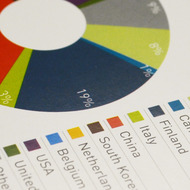In 2017-18 resource production was worth almost $115 billion and included record sales volumes across a number of commodities.
| Date: | Thursday, 27 September 2018 |
|---|
Western Australia's mineral and petroleum industry reported sales of $114.9 billion, up $10 billion from 2016-17 according to the latest statistics released by the Department of Mines, Industry Regulation and Safety.
The amount was the second highest financial year sales value on record, behind only the $123 billion achieved in 2013-14, with a number of commodities reaching record production levels including gold, iron ore, LNG and lithium.
Liquefied natural gas saw the largest increase in value, climbing from $12.7 billion to $19.1 billion, coming off the back of a 32 per cent increase in production.
Lithium continued to see significant increases in both production and value, with sales rising 167 per cent to reach $1.6 billion from production of 2.1 million tonnes.
Annual employment figures for the State's mining industry also increased to 112,008 people, up from 106,490 the previous financial year.
Mineral sector highlights
Mineral commodities still dominate the State’s resources sector, accounting for 77 per cent, or $88 billion, of total sales value. Iron ore was by far the most valuable commodity, accounting for 70 per cent of mineral sales and 54 per cent of overall sales.
Iron ore recorded sales valued at $61.7 billion in 2017–18, down slightly (3 per cent) on last year. Record sales volumes of almost 826 million tonnes was not enough to offset the lower prices received by Western Australian producers.
Gold sales volumes increased for the third year in a row to reach a record 212 tonnes (7.5 million ounces) in 2017–18. Increased volumes combined with strong gold prices to deliver a 5 per cent increase in the value of the sector, from $10.8 billion in 2016–17 to $11.4 billion in 2017–18.
Alumina and bauxite sales accounted for 7.5 per cent of mineral sales and 6 per cent of total sales. Sales volumes increased more than 4 per cent year–on–year, attributable to a substantial increase in bauxite sales, which offset a decrease in alumina sales. This meant that the value of the sector increased 30 per cent to $6.6 billion in 2017–18.
Western Australia’s nickel sector has struggled in recent years, with the value of the sector declining year-on-year since 2010–11. However, in 2017–18, fortunes turned with the value of the sector increasing 26 per cent from $2.1 billion in 2016–17 to $2.6 billion in 2017–18.
Petroleum sector highlights
The petroleum sector, which comprises crude oil, condensate, LNG, natural gas and LPG, accounted for 23 per cent of the total value of Western Australia’s mineral and petroleum sales in 2017–18. This made it the second most valuable sector after iron ore.
The sector was valued at $26.6 billion in 2017–18, an increase of 39 per cent from $19.2 billion in 2016–17.
LNG remains Western Australia’s most valuable petroleum product, accounting for close to 17 per cent of all mineral and petroleum sales in 2017–18. The value of LNG sales value rose just over $6 billion from $12.7 billion in 2016–17 to $19.1 billion in 2017–18.
The volume of LNG produced in Western Australia increased 45 per cent during the five years to 2016–17 and a further 32 per cent in 2017–18. This follows the start-up of several new LNG projects over the period marking the last of the “mega” LNG investment projects to reach production.
In 2017–18, crude oil volumes were down 11 per cent to 4.8 gigalitres, while condensate production increased 18 per cent to 7.1 gigalitres. Improvements in the prices received by Western Australian producers contributed to the increase in the value of crude oil and condensate sales which rose for the first time in seven years from $4.3 billion in 2016–17 to $5.6 billion in 2017–18.
The statistics cover the 2017-18 financial year and are available from the department's website.

